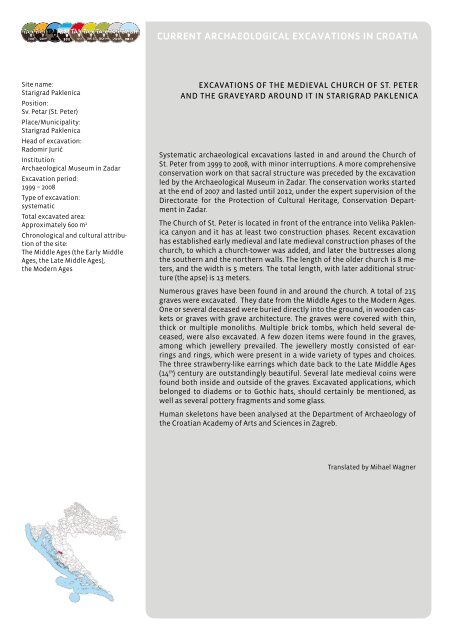AMZ_TAIUH_2017_ prijevodi na engleski
Create successful ePaper yourself
Turn your PDF publications into a flip-book with our unique Google optimized e-Paper software.
CURRENT ARCHAEOLOGICAL EXCAVATIONS IN CROATIA<br />
Site <strong>na</strong>me:<br />
Starigrad Paklenica<br />
Position:<br />
Sv. Petar (St. Peter)<br />
Place/Municipality:<br />
Starigrad Paklenica<br />
Head of excavation:<br />
Radomir Jurić<br />
Institution:<br />
Archaeological Museum in Zadar<br />
Excavation period:<br />
1999 – 2008<br />
Type of excavation:<br />
systematic<br />
Total excavated area:<br />
Approximately 600 m 2<br />
Chronological and cultural attribution<br />
of the site:<br />
The Middle Ages (the Early Middle<br />
Ages, the Late Middle Ages),<br />
the Modern Ages<br />
EXCAVATIONS OF THE MEDIEVAL CHURCH OF ST. PETER<br />
AND THE GRAVEYARD AROUND IT IN STARIGRAD PAKLENICA<br />
Systematic archaeological excavations lasted in and around the Church of<br />
St. Peter from 1999 to 2008, with minor interruptions. A more comprehensive<br />
conservation work on that sacral structure was preceded by the excavation<br />
led by the Archaeological Museum in Zadar. The conservation works started<br />
at the end of 2007 and lasted until 2012, under the expert supervision of the<br />
Directorate for the Protection of Cultural Heritage, Conservation Department<br />
in Zadar.<br />
The Church of St. Peter is located in front of the entrance into Velika Paklenica<br />
canyon and it has at least two construction phases. Recent excavation<br />
has established early medieval and late medieval construction phases of the<br />
church, to which a church-tower was added, and later the buttresses along<br />
the southern and the northern walls. The length of the older church is 8 meters,<br />
and the width is 5 meters. The total length, with later additio<strong>na</strong>l structure<br />
(the apse) is 13 meters.<br />
Numerous graves have been found in and around the church. A total of 215<br />
graves were excavated. They date from the Middle Ages to the Modern Ages.<br />
One or several deceased were buried directly into the ground, in wooden caskets<br />
or graves with grave architecture. The graves were covered with thin,<br />
thick or multiple monoliths. Multiple brick tombs, which held several deceased,<br />
were also excavated. A few dozen items were found in the graves,<br />
among which jewellery prevailed. The jewellery mostly consisted of earrings<br />
and rings, which were present in a wide variety of types and choices.<br />
The three strawberry-like earrings which date back to the Late Middle Ages<br />
(14 th ) century are outstandingly beautiful. Several late medieval coins were<br />
found both inside and outside of the graves. Excavated applications, which<br />
belonged to diadems or to Gothic hats, should certainly be mentioned, as<br />
well as several pottery fragments and some glass.<br />
Human skeletons have been a<strong>na</strong>lysed at the Department of Archaeology of<br />
the Croatian Academy of Arts and Sciences in Zagreb.<br />
Translated by Mihael Wagner


